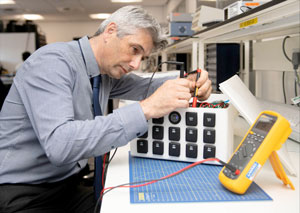| Aug 13, 2019 |
Researchers convert used car batteries into units that could power farms in the developing world
|
|
(Nanowerk News) As part of a Circular Economy for electric vehicle battery systems, as the number of such vehicles increases rapidly, the need to find the best way to reuse and recycle vehicle batteries becomes just as intense.
|
|
Now researchers at WMG, University of Warwick, have found a way not just to recycle those used batteries, but repurpose them as small energy storage systems (ESS) for off grid locations in developing countries or isolated communities. The repurposed units, each containing approximately 2kWh of energy capacity, will be able to power a small shop, a farm holding, or multiple residential homes.
|
|
WMG’s Professor James Marco who was lead researcher on the project said: “When an electric vehicle’s battery reaches the end of its useful life it is by no means massively depleted. It has simply reached the end of its useful life in a vehicle. It is generally accepted that an EV battery has reached end of life when its capacity drops to 80% of a fresh battery. While this is no longer enough to satisfy drivers, it remains immensely useful for anyone who seeks to use the battery in a static situation.”
|
 |
| Professor James Marco in the lab. (Image: WMG, University of Warwick)
|
|
While such partially depleted batteries remain potentially very useful to other users there are still challenges to overcome, particularly to ensure that they can be used reliably, sustainably, and cheaply in remote locations. These challenges include:
|
|
How to protect the lithium-ion cells from over-charge and discharge
Can the ESS be made compatible with a variety of other used battery cells and modules from other manufacturers
How to keep it low cost and easy maintenance, while providing an interface that is easy to use and understand.
|
|
The WMG team, at the University of Warwick, set about overcoming these challenges with the help of the WMG HVM Catapult and Jaguar Land Rover who supplied batteries and components from the Jaguar I-PACE, their first all-electric performance SUV. The team designed a new Battery Management System (BMS) and packaging that allowed them to create a working and easily portable prototype ESS which included:
|
|
The use of standard low cost components for control, communication and safety functions. All parts were either sourced from the JLR service department or were low cost components purchased from any electrical retailer
The ability to use different modules that could be interchanged within the 2nd-life system without having to recalibrate the whole BMS
Enough energy for a small shop, farm holding or multiple residential homes
Multiple 12V DC sockets and 5V USB charge ports
The ability to have the 2nd –life module charged via reclaimed laptop chargers
Simplified control system for easy integration and deployment.
|
|
Professor James Marco continues: “This is a great result that not only provides a highly efficient repurposing solution for automotive batteries but which could also change lives in remote communities. We are now looking for support to allow these new units to be further developed and tested in remote or off grid locations.”
|

